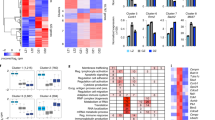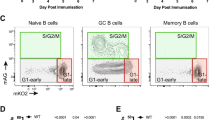Abstract
Germinal center (GC) dark and light zones segregate cells undergoing somatic hypermutation and antigen-driven selection, respectively, yet the factors guiding this organization are unknown. We report here that GC organization was absent from mice deficient in the chemokine receptor CXCR4. Centroblasts had high expression of CXCR4 and GC B cells migrated toward the CXCR4 ligand SDF-1 (CXCL12), which was more abundant in the dark zone than in the light zone. CXCR4-deficient cells were excluded from the dark zone in the context of a wild-type GC. These findings establish that GC organization depends on sorting of centroblasts by CXCR4 into the dark zone. In contrast, CXCR5 helped direct cells to the light zone and deficiency in CXCL13 was associated with aberrant light zone localization.
This is a preview of subscription content, access via your institution
Access options
Subscribe to this journal
Receive 12 print issues and online access
$209.00 per year
only $17.42 per issue
Buy this article
- Purchase on Springer Link
- Instant access to full article PDF
Prices may be subject to local taxes which are calculated during checkout







Similar content being viewed by others
Change history
08 August 2004
appended erratum PDF to back of AOP PDF; placed footnote in XML at every instance of Fig. 1; corrected online date will appear in issue PDF.
Notes
*Note: In the version of this article originally published online, the labels in Figure 1b were positioned incorrectly. This error has been corrected for the HTML and print versions of this article.
References
Röhlich, K. Beitrag zur Cytologie der Keimzentren der Lymphknoten. Z. Mikrosk. Anat. Forsch. 20, 287–297 (1930).
MacLennan, I.C. Germinal centers. Annu. Rev. Immunol. 12, 117–139 (1994).
Kelsoe, G. Life and death in germinal centers (redux). Immunity 4, 107–111 (1996).
McHeyzer-Williams, M.G. & Ahmed, R. B cell memory and the long-lived plasma cell. Curr. Opin. Immunol. 11, 172–179 (1999).
Berek, C., Berger, A. & Apel, M. Maturation of the immune response in germinal centers. Cell 67, 1121–1129 (1991).
Liu, Y.J., Zhang, J., Lane, P.J., Chan, E.Y. & MacLennan, I.C. Sites of specific B cell activation in primary and secondary responses to T cell-dependent and T cell-independent antigens. Eur. J. Immunol. 21, 2951–2962 (1991).
Koburg, E. in Germinal Centers in Immune Responses. (eds. Cottier, H., Odartchenko, N, Schindler, R. & Congdon, C.C.) 177–182 (Springer-Verlag, New York, University of Bern, Switzerland; 1966).
Koopman, G. et al. Adhesion of human B cells to follicular dendritic cells involves both the lymphocyte function-associated antigen 1/intercellular adhesion molecule 1 and very late antigen 4/vascular cell adhesion molecule 1 pathways. J. Exp. Med. 173, 1297–1304 (1991).
Freedman, A.S. et al. Adhesion of human B cells to germinal centers in vitro involves VLA-4 and INCAM-110. Science 249, 1030–1033 (1990).
Voigt, I. et al. CXCR5-deficient mice develop functional germinal centers in the splenic T cell zone. Eur. J. Immunol. 30, 560–567 (2000).
Ansel, K.M. et al. A chemokine-driven positive feedback loop organizes lymphoid follicles. Nature 406, 309–314 (2000).
Forster, R. et al. A putative chemokine receptor, BLR1, directs B cell migration to defined lymphoid organs and specific anatomic compartments of the spleen. Cell 87, 1037–1047 (1996).
Roy, M.P., Kim, C.H. & Butcher, E.C. Cytokine control of memory B cell homing machinery. J. Immunol. 169, 1676–1682 (2002).
Bowman, E.P. et al. Developmental switches in chemokine response profiles during B cell differentiation and maturation. J. Exp. Med. 191, 1303–1318 (2000).
Bleul, C.C., Schultze, J.L. & Springer, T.A. B lymphocyte chemotaxis regulated in association with microanatomic localization, differentiation state, and B cell receptor engagement. J. Exp. Med. 187, 753–762 (1998).
Forster, R. et al. Intracellular and surface expression of the HIV-1 coreceptor CXCR4/fusin on various leukocyte subsets: rapid internalization and recycling upon activation. J. Immunol. 160, 1522–1531 (1998).
Casamayor-Palleja, M., Mondiere, P., Verschelde, C., Bella, C. & Defrance, T. BCR ligation reprograms B cells for migration to the T zone and B-cell follicle sequentially. Blood 99, 1913–1921 (2002).
Estes, J.D. et al. Follicular dendritic cell-mediated up-regulation of CXCR4 expression on CD4 T cells and HIV pathogenesis. J. Immunol. 169, 2313–2322 (2002).
Corcione, A. et al. Stromal cell-derived factor-1 as a chemoattractant for follicular center lymphoma B cells. J. Natl. Cancer Inst. 92, 628–635 (2000).
Shinall, S.M., Gonzalez-Fernandez, M., Noelle, R.J. & Waldschmidt, T.J. Identification of murine germinal center B cell subsets defined by the expression of surface isotypes and differentiation antigens. J. Immunol. 164, 5729–5738 (2000).
Maeda, K. et al. Murine follicular dendritic cells and low affinity Fc receptors for IgE (FcεRII). J. Immunol. 148, 2340–2347 (1992).
Cyster, J.G. et al. Follicular stromal cells and lymphocyte homing to follicles. Immunol. Rev. 176, 181–193 (2000).
Vonderheide, R.H. & Hunt, S.V. Does the availability of either B cells or CD4+ cells limit germinal centre formation? Immunology 69, 487–489 (1990).
Tamamura, H. et al. Enhancement of the T140-based pharmacophores leads to the development of more potent and bio-stable CXCR4 antagonists. Org. Biomol. Chem. 1, 3663–3669 (2003).
Strasser, A. et al. Enforced BCL2 expression in B-lymphoid cells prolongs antibody responses and elicits autoimmune disease. Proc. Natl. Acad. Sci. USA 88, 8661–8665 (1991).
Secord, E.A., Edington, J.M. & Thorbecke, G.J. The Eμ-bcl-2 transgene enhances antigen-induced germinal center formation in both BALB/c and SJL mice but causes age-dependent germinal center hyperplasia only in the lymphoma-prone SJL strain. Am. J. Pathol. 147, 422–433 (1995).
Smith, K.G. et al. Bcl-2 transgene expression inhibits apoptosis in the germinal center and reveals differences in the selection of memory B cells and bone marrow antibody-forming cells. J. Exp. Med. 191, 475–484 (2000).
Hargreaves, D.C. et al. A coordinated change in chemokine responsiveness guides plasma cell movements. J. Exp. Med. 194, 45–56 (2001).
Okada, T. et al. Chemokine requirements for B cell entry to lymph nodes and Peyer's patches. J. Exp. Med. 196, 65–75 (2002).
Krug, A. et al. IFN-producing cells respond to CXCR3 ligands in the presence of CXCL12 and secrete inflammatory chemokines upon activation. J. Immunol. 169, 6079–6083 (2002).
Casamayor-Palleja, M. et al. Expression of macrophage inflammatory protein-3alpha, stromal cell-derived factor-1, and B-cell-attracting chemokine-1 identifies the tonsil crypt as an attractive site for B cells. Blood 97, 3992–3994 (2001).
Amara, A. et al. Stromal cell-derived factor-1alpha associates with heparan sulfates through the first β-strand of the chemokine. J. Biol. Chem. 274, 23916–23925 (1999).
Nieuwenhuis, P. & Opstelten, D. Functional anatomy of germinal centers. Am. J. Anat. 170, 421–435 (1984).
Wehrli, N. et al. Changing responsiveness to chemokines allows medullary plasmablasts to leave lymph nodes. Eur. J. Immunol. 31, 609–616 (2001).
Guinamard, R. et al. B cell antigen receptor engagement inhibits stromal cell-derived factor (SDF)-1α chemotaxis and promotes protein kinase C (PKC)-induced internalization of CXCR4. J. Exp. Med. 189, 1461–1466 (1999).
Marchese, A. & Benovic, J.L. Agonist-promoted ubiquitination of the G protein-coupled receptor CXCR4 mediates lysosomal sorting. J. Biol. Chem. 276, 45509–45512 (2001).
Balogh, P., Aydar, Y., Tew, J.G. & Szakal, A.K. Appearance and phenotype of murine follicular dendritic cells expressing VCAM-1. Anat. Rec. 268, 160–168 (2002).
Egawa, T. et al. The earliest stages of B cell development require a chemokine stromal cell-derived factor/pre-B cell growth-stimulating factor. Immunity 15, 323–334 (2001).
Ma, Q. et al. Impaired B-lymphopoiesis, myelopoiesis, and derailed cerebellar neuron migration in CXCR4- and SDF-1-deficient mice. Proc. Natl. Acad. Sci. USA 95, 9448–9453 (1998).
Zou, Y.R., Kottmann, A.H., Kuroda, M., Taniuchi, I. & Littman, D.R. Function of the chemokine receptor CXCR4 in haematopoiesis and in cerebellar development. Nature 393, 595–599 (1998).
Ara, T. et al. A role of CXC chemokine ligand 12/stromal cell-derived factor-1/pre-B cell growth stimulating factor and its receptor CXCR4 in fetal and adult T cell development in vivo. J. Immunol. 170, 4649–4655 (2003).
Plotkin, J., Prockop, S.E., Lepique, A. & Petrie, H.T. Critical role for CXCR4 signaling in progenitor localization and T cell differentiation in the postnatal thymus. J. Immunol. 171, 4521–4527 (2003).
Martin, C. et al. Chemokines acting via CXCR2 and CXCR4 control the release of neutrophils from the bone marrow and their return following senescence. Immunity 19, 583–593 (2003).
Bleul, C.C., Fuhlbrigge, R.C., Casasnovas, J.M., Aiuti, A. & Springer, T.A. A highly efficacious lymphocyte chemoattractant, stromal cell-derived factor 1 (SDF-1). J. Exp. Med. 184, 1101–1109 (1996).
Hernandez, P.A. et al. Mutations in the chemokine receptor gene CXCR4 are associated with WHIM syndrome, a combined immunodeficiency disease. Nat. Genet. 34, 70–74 (2003).
Luther, S.A., Gulbranson-Judge, A., Acha-Orbea, H. & MacLennan, I.C. Viral superantigen drives extrafollicular and follicular B cell differentiation leading to virus-specific antibody production. J. Exp. Med. 185, 551–562 (1997).
Ngo, V.N., Tang, H.L. & Cyster, J.G. Epstein-Barr virus-induced molecule 1 ligand chemokine is expressed by dendritic cells in lymphoid tissues and strongly attracts naive T cells and activated B cells. J. Exp. Med. 188, 181–191 (1998).
Cinamon, G. et al. Sphingosine 1-phosphate receptor 1 promotes B cell localization in the splenic marginal zone. Nat. Immunol. 5, 713–720 (2004).
Acknowledgements
We thank D. Hargreaves, Y. Xu and M. Lesneski for technical assistance; C. Miller for training in laser-capture microdissection; J. Dietrich for surgical expertise; S. Jiang for cell sorting; D. Littman for Cxcr4+/− mice; M. Lipp for Cxcr5−/− mice; T. Roach for some Eμ-Bcl2-22 mice; F. Arenzana-Seisdedos for K15C antibody; J. Lin and other members of the Weiss Lab for Jurkat cells; the Werb lab for the use of equipment and supplies; the University of California San Francisco Diabetes Center for use of the ABI Prism 7900HT; S. Luther, T. Okada and G. Cinamon for advice and comments on the manuscript; and M. Matloubian, C. Lo and J. Cholfin for discussions. Work supported by Howard Hughes Medical Institute and grants AI40098 and AI45073 from the National Institutes of Health, and by predoctoral grants from Howard Hughes Medical Institute (C.D.C.A. and K.M.A.).
Author information
Authors and Affiliations
Corresponding author
Ethics declarations
Competing interests
The authors declare no competing financial interests.
Supplementary information
Supplementary Fig. 1
GCs in Eμ-bcl-2-22 transgenic mice have normal dark and light zone polarity. (PDF 74 kb)
Supplementary Table 1
Antibodies used in flow cytometry. (PDF 18 kb)
Supplementary Table 2
Primary antibodies used in mouse immunohistochemistry. (PDF 19 kb)
Supplementary Table 3
Secondary antibodies used in mouse immunohistochemistry. (PDF 17 kb)
Supplementary Table 4
Primer and probe sequences for quantitative real-time PCR. (PDF 18 kb)
Rights and permissions
About this article
Cite this article
Allen, C., Ansel, K., Low, C. et al. Germinal center dark and light zone organization is mediated by CXCR4 and CXCR5. Nat Immunol 5, 943–952 (2004). https://doi.org/10.1038/ni1100
Received:
Accepted:
Published:
Issue Date:
DOI: https://doi.org/10.1038/ni1100
This article is cited by
-
B cell development and antibody responses in human immune system mice: current status and future perspective
Science China Life Sciences (2024)
-
Conserved stromal–immune cell circuits secure B cell homeostasis and function
Nature Immunology (2023)
-
Dynamic mitochondrial transcription and translation in B cells control germinal center entry and lymphomagenesis
Nature Immunology (2023)
-
Role and application of chemokine CXCL13 in central nervous system lymphoma
Annals of Hematology (2023)
-
Spatial dysregulation of T follicular helper cells impairs vaccine responses in aging
Nature Immunology (2023)



